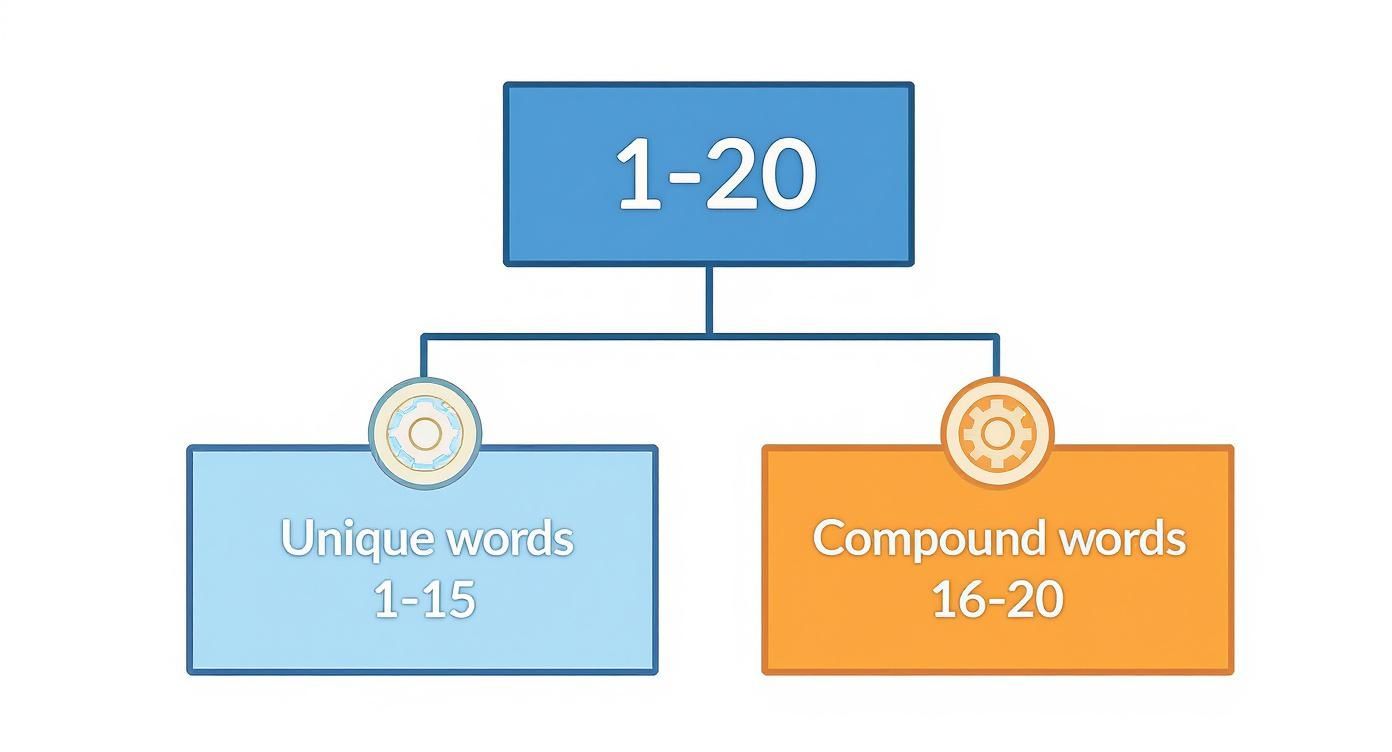Master numbers in spanish: Counting from 1 to 1000
Learning numbers in Spanish all starts with a solid foundation. The first twenty numbers you learn, from uno (one) to veinte (twenty), are the absolute cornerstones. Get these down, and you’ll find building every other number is surprisingly straightforward.
Your Foundation for Counting in Spanish: 1–20
Think of the numbers 1 to 20 as the alphabet of Spanish counting. Once you’ve got them memorised, the patterns for everything else just click into place. It’s the first big hurdle, but many learners find that after mastering this set, the rest of the system feels much more logical.
The numbers up to fifteen are unique words, so you’ll just have to memorise them. But from sixteen onwards, you get the first glimpse of a system. For example, dieciséis (sixteen) is really just a mash-up of diez y seis ("ten and six"). This is a little preview of how larger numbers are put together.
A Closer Look at the First Twenty Numbers
Really spend some time getting this first set right. Nailing the spelling and pronunciation now will save you a lot of headaches later on and give you a huge confidence boost. It's all about repetition—practice them until they roll off your tongue. If you're curious about the learning curve, you can read more about whether Spanish is easy to learn to get some extra context for your journey.
A strong grasp of the numbers 1-20 is non-negotiable for anyone serious about learning Spanish. These numbers appear constantly in daily conversations, from telling time and making purchases to sharing your age or address.
To help you get started, here’s a quick-reference table with the numbers from one to twenty, complete with a simple pronunciation guide to get you sounding natural from day one.
Spanish Numbers 1-20 with Pronunciation
This table breaks down the essentials. Don't just read them—say them out loud!
| Number | Spanish Word | Pronunciation Guide |
|---|---|---|
| 1 | uno | oo-no |
| 2 | dos | dohs |
| 3 | tres | trehs |
| 4 | cuatro | kwah-troh |
| 5 | cinco | seen-koh |
| 6 | seis | seh-ees |
| 7 | siete | see-eh-teh |
| 8 | ocho | oh-choh |
| 9 | nueve | nweh-beh |
| 10 | diez | dee-ehs |
| 11 | once | ohn-seh |
| 12 | doce | doh-seh |
| 13 | trece | treh-seh |
| 14 | catorce | kah-tohr-seh |
| 15 | quince | keen-seh |
| 16 | dieciséis | dee-eh-see-seh-ees |
| 17 | diecisiete | dee-eh-see-see-eh-teh |
| 18 | dieciocho | dee-eh-see-oh-choh |
| 19 | diecinueve | dee-eh-see-nweh-beh |
| 20 | veinte | beh-een-teh |
Keep this list handy and practice regularly. Soon enough, you won’t even have to think about them. They’ll just be there when you need them.
Building Numbers in Spanish from 21 to 100
Once you've nailed the first 20 numbers, the journey to 100 gets a lot easier. The system shifts from memorising unique words to applying a predictable pattern. Think of it like learning the basic chords on a guitar; once you get those down, you can start stringing them together to play all sorts of songs.
The numbers from 21 to 29 follow their own special rule. They all kick off with the prefix "veinti-", which is basically a smooshed-together version of veinte y ("twenty and"). You just attach this prefix directly to the single-digit number that follows.
For instance, the number 21 is veintiuno—a mash-up of veinti and uno. See how it flows into a single word? This handy structure is the same for the rest of the twenties.
The Special Case of the Twenties
The "veinti-" family is the last group of two-digit numbers in Spanish that are typically written as one solid word. This makes them a unique bridge between the foundational numbers (1-20) and the more logical, formulaic ones that come next.
Here’s a quick rundown of the numbers 21-29:
- 21: veintiuno
- 22: veintidós
- 23: veintitrés
- 24: veinticuatro
- 25: veinticinco
- 26: veintiséis
- 27: veintisiete
- 28: veintiocho
- 29: veintinueve
Try saying these out loud. You can almost hear the rhythm of "twenty-and-one," "twenty-and-two," etc., just all fused together.
This infographic lays out how the first 20 numbers are built, showing the separation between the one-of-a-kind words and the first compound numbers.
As you can see, right after fifteen, Spanish numbers start using a compound structure, which perfectly sets the stage for the easy patterns you'll use from 31 onwards.
The "Tens and One" Formula from 31 Onwards
From 31 on up, counting becomes wonderfully straightforward and consistent. The single-word structure is gone, replaced by a simple three-part formula: the ten + y + the one.
The little word "y" just means "and." So, to say 31, you literally say "thirty and one," which is treinta y uno. This logical pattern is your best friend all the way to 99.
This "tens + y + ones" structure is the key to unlocking the rest of the numbers up to 100. Once you learn the tens, you can build any number in between by just popping in "y" and the single digit you already know.
So, let's learn the tens. These are the only new words you need to memorise for this stage.
- 30: treinta
- 40: cuarenta
- 50: cincuenta
- 60: sesenta
- 70: setenta
- 80: ochenta
- 90: noventa
- 100: cien
Armed with these words, you can form any number. For example, if you want to say 45, you just take cuarenta (40), add y, and then add cinco (5) to get cuarenta y cinco. Need to say 88? It's simply ochenta y ocho. This simple, repeatable formula is your ticket to counting confidently all the way to 100.
Counting into the Hundreds and Thousands
Once you've got a solid grip on counting to 100, you'll find that stepping up to the hundreds and thousands is surprisingly logical. The patterns you've already picked up just keep on rolling, with only a handful of new terms to add to your toolkit. Think of it like this: you've already built the ground floor, and now you're just adding more levels on top. The foundation is strong.
The first word you'll need is ciento, which means "one hundred". To count past 100, you simply attach the numbers you already know. For example, 101 is ciento uno, and 155 becomes ciento cincuenta y cinco. It's the same "tens and ones" logic you've been using, just with a new building block at the start.
There is, however, one small but crucial trick to know about the number 100 itself.
When Ciento Becomes Cien
The word ciento gets a little shorter, becoming cien, in two specific situations: when you mean exactly 100, or when it comes right before a noun or the word mil (thousand). It's a bit like the difference between saying "one hundred" versus "a hundred" in English—subtle, but it matters.
For instance, you would say:
- Hay cien libros. (There are 100 books.)
- Tengo cien dólares. (I have 100 dollars.)
- Necesito cien mil pesos. (I need 100,000 pesos.)
But as soon as you add another number to it, it snaps back to the longer form, ciento:
- Hay ciento un libros. (There are 101 books.)
Getting the hang of cien versus ciento is one of those fine points that really makes your Spanish sound authentic. When you use cien correctly before a noun, it's a dead giveaway that you're moving past the basics.
Building the Hundreds
From 200 onwards, the hundreds follow a satisfyingly consistent pattern. You just take the single-digit number (2 through 9) and stick the plural form -cientos onto the end. Simple.
Here’s a quick rundown of the hundreds:
- 200: doscientos
- 300: trescientos
- 400: cuatrocientos
- 500: quinientos (Watch out, this one's irregular!)
- 600: seiscientos
- 700: setecientos (Another slightly tricky one!)
- 800: ochocientos
- 900: novecientos (And the last of the irregulars!)
Nailing these larger numbers is vital for real-world tasks like talking about prices, discussing historical dates, or working with any kind of data. After all, with nearly 483 million native speakers, Spanish is the world's second most spoken native language after Mandarin Chinese. Being able to handle big numbers opens up clear communication with a huge global community. You can find more insights on the global reach of Spanish over at Academia Contacto.
From here, building even bigger numbers is a piece of cake. 250 is just doscientos cincuenta, and 999 is novecientos noventa y nueve. The word for "one thousand" is simply mil. Two thousand? Dos mil. Ten thousand? Diez mil. There's no hidden complexity—you just state the number and add mil. It’s this logical system that lets you construct massive figures with total confidence.
Using Ordinal Numbers for Rank and Order
https://www.youtube.com/embed/TV__ZddhP0Q
You've got the hang of counting things, which is a massive step. But what about when you need to put those things in order? That's where a different set of numbers, called ordinals, comes in handy. Instead of uno, dos, tres (one, two, three), you'll start using words like primero, segundo, tercero to talk about first, second, and third place.
Think about all the times we use this in daily life. You might be looking for the segundo piso (second floor) in a building or celebrating your primer aniversario (first anniversary). Ordinals are essential for describing sequence and position. The good news is, while they technically go on forever, you'll find that just knowing the first ten will get you through most real-world conversations.
The First Ten Ordinal Numbers
Let's nail down the basics. These are the words you’ll need for everything from discussing who won a race to telling a taxi driver which street to take.
Here are the top ten ordinal numbers you should know:
- Primero (First)
- Segundo (Second)
- Tercero (Third)
- Cuarto (Fourth)
- Quinto (Fifth)
- Sexto (Sixth)
- Séptimo (Seventh)
- Octavo (Eighth)
- Noveno (Ninth)
- Décimo (Tenth)
Memorise these, and you're well on your way to sounding much more like a native speaker.
A Key Rule for Primero and Tercero
Spanish has a cool little quirk that, once you master it, will make you sound incredibly natural. The words primero (first) and tercero (third) actually shorten themselves, dropping the final "-o" whenever they're placed before a singular masculine noun. It’s a subtle tweak, but it makes a huge difference.
Take a look:
- El primer día (The first day)
- Mi tercer hijo (My third son)
See how we use primer and tercer instead of the full words? This simple adjustment is a dead giveaway that you know your stuff.
Of course, if the noun is feminine, the rule changes slightly, which brings us to another core concept in Spanish.
Ordinal numbers in Spanish must agree in gender with the noun they describe. This means changing the final "-o" to an "-a" for feminine nouns, a fundamental rule you'll see across Spanish grammar.
For example, you'd say la primera vez (the first time) or la tercera persona (the third person). This gender agreement applies to all ordinal numbers, not just a select few. Paying attention to this detail is one of those small things that adds up to a big leap in your fluency and confidence.
Common Mistakes and Practical Applications
Alright, let's get down to the practical side of things. It’s one thing to memorise lists of numbers in Spanish, but it’s a whole different ball game using them confidently when you’re ordering coffee, telling someone your age, or asking for a price. This is where the real learning happens—when theory meets real life.
We'll start with some everyday situations where you'll need numbers, then dive into the most common slip-ups learners make. By tackling these common hurdles head-on, you'll be well on your way to sounding more natural in your conversations.
Putting Numbers to Work in Daily Scenarios
You'll find that Spanish numbers pop up everywhere in day-to-day interactions. From making plans with a friend to booking a table at a restaurant, you simply can't avoid them. Here are a few key areas where you can start practising right away.
- Telling Time: When someone asks for the time, you'll need numbers. For "It's three o'clock," you'd say, Son las tres. For 3:15, it's Son las tres y cuarto.
- Stating Your Age: This is a classic. You'd say, Tengo treinta años (I am thirty years old). The key here is using the verb tengo (I have), not soy (I am). It's a direct translation quirk you just have to remember!
- Giving the Date: To say "It's May 5th," you’d state, Es el cinco de mayo. Unlike English, Spanish almost always uses cardinal numbers for dates. The only exception is the first of the month, where el primero is common.
- Talking About Prices: At a shop, you might ask, ¿Cuánto cuesta? (How much does it cost?). A likely reply would be something like, Cuesta veinte euros (It costs twenty euros).
If you find certain numbers or sequences especially tricky to remember, a great tip is to create powerful mnemonics to build strong, memorable links.
Sidestepping Common Learner Mistakes
Every Spanish learner stumbles over numbers at some point. Knowing where the pitfalls are is the best way to avoid them. Let's walk through a few of the most common mistakes that can trip people up.
First up is the classic un vs. uno confusion. The number one, uno, gets shortened to un whenever it comes before a masculine noun. So, you'd say Tengo un libro (I have one book), never Tengo uno libro.
The full word uno is reserved for when you're counting ("…uno, dos, tres…") or when it stands alone without a noun. If someone asks, ¿Cuántos necesitas? (How many do you need?), you can simply answer, Necesito uno (I need one).
Another common tripwire is the word "y" (and). Remember this rule: you only use y to connect the tens and ones places for numbers between 31 and 99 (like in cuarenta y cinco for 45). It's a common error to say something like ciento y cinco for 105. The correct form is just ciento cinco.
Finally, don't forget about gender agreement! It’s easy to overlook, but numbers ending in -uno change to -una before a feminine noun. For example, it's veinti*una chicas* (21 girls), not veintiuno chicas. Nailing these little details will make your Spanish sound much more polished and natural. The best way to get these right is practice, and you might find it helpful to look for a language exchange partner in Singapore to get some real-world conversation time.
Your Questions About Spanish Numbers Answered
As you start getting the hang of Spanish numbers, a few common questions always seem to surface. These are the little nuances that separate someone who knows the numbers from someone who can use them naturally. Let’s tackle some of the most frequent sticking points so you can speak with more confidence.
A big one is regional differences. Do numbers change much between Spain and Latin America? For the most part, no. The fundamental system—uno, dos, tres, diez, cien, mil—is the same everywhere. You can count, tell time, and talk about money the same way in Madrid as you would in Mexico City.
Where you might catch slight differences is in pronunciation or local slang. The most notable variation pops up with massive numbers. In most of Latin America, a "billion" is mil millones (a thousand million). However, Spain sometimes uses un billón to mean a trillion (a million million), which comes from an older counting system. For day-to-day conversation, though, you’ll rarely run into this.
Cien Versus Ciento Explained
One of the first hurdles everyone hits is the number 100. When do you use cien and when is ciento the right move? Thankfully, the rule is pretty simple once you see it.
Use the short form, cien, when you mean exactly one hundred of something. It sits right before a noun, acting like an adjective. The longer form, ciento, is what you use when it's part of a bigger number, like 101 or 150.
Here’s a quick side-by-side to make it click:
- Cien personas (100 people)
- Cien dólares ($100)
- Ciento una personas (101 people)
- Ciento cincuenta dólares ($150)
Just think of cien as "a hundred" and ciento as the "one hundred" building block for larger numbers. Getting this right is a small change that instantly makes your Spanish sound much more polished.
How to Say the Date and Year Correctly
Talking about dates, especially the year, can feel a bit clunky at first. The good news? Spanish is very logical here. To say a full date, the formula is "the [day] of [month] of [year]." For instance, 15 September 2024, becomes el quince de septiembre de dos mil veinticuatro. Easy enough.
For years in the 1900s, like 1995, you have to say the whole thing: mil novecientos noventa y cinco (one thousand, nine hundred, ninety-five). There’s no "nineteen ninety-five" shortcut like in English. It feels like a mouthful, but it's fantastic practice for handling those larger numbers.
Even in places you might not expect, like Singapore, there's a growing community of dedicated Spanish learners. In fact, 48.6% of Spanish speakers in Singapore are young adults between 25-34, a group often motivated by career and educational aspirations. This just goes to show the global desire to master these linguistic details, and you can learn more about the diverse language communities in Singapore on Wikipedia. For anyone in the area, finding the right support is crucial. A dedicated language school in Singapore can offer the structured learning needed to truly master these finer points of the language.
At Spanish Council Singapore, our focus is on helping you master these practical details. Our native teachers guide you through real-world scenarios so you can use Spanish numbers accurately and with total confidence. https://spanish.sg















